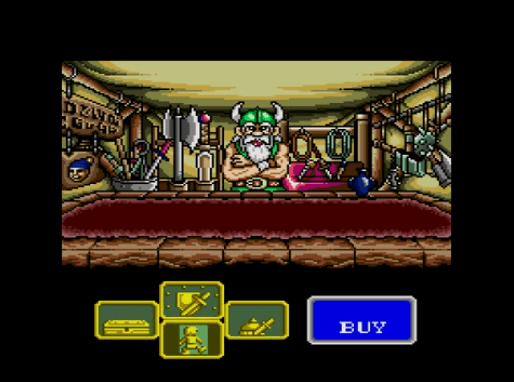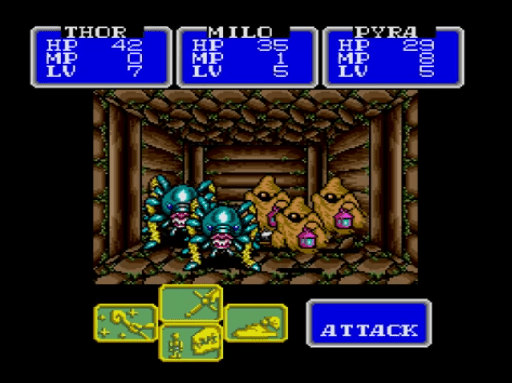
Shining in the Darkness (Shining and the Darkness in Japan) is a role-playing game developed by Climax Entertainment and Sonic Software Planning, and was published by Sega in 1991 for the Mega Drive. This was the version I chose to review.

Plot
In the Kingdom of Thornwood, the king’s daughter, Princess Jessa, has disappeared whilst visiting the shrine of her deceased mother. Mortred, one of the king’s most brave and trusted knights, was charged with escorting her to the shrine. He is also missing. You take control of Mortred’s son and agree to be the search party.
Gameplay
Shining in the Darkness is a real dungeon crawler that sees your character, along with friends Milo and Pyra, exploring what seems like endless miles of dungeons. Along the way you have random encounters with all manner of ugly beasts. Deafeating these will help your team gain experience points and level up, increasing stats and allowing new spells to be learnt. Gold is also acquired which allows you to buy new weapons and armour.
When leaving the palace, a map appears showing you the three locations you can visit: the palace, the town or the dungeons. In the town you can visit the shrine to save your progress; enter the tavern to talk to some interesting characters and regain your health with an overnight stay; visit the weaponry and armoury where you can upgrade to stronger weapons and armour; and buy antidotes and healing potions needed for your adventures in the dungeon from the Alkemist (not alchemist I might add).

Moving through the dungeons is simple. You can move forwards, walk backwards and turn left or right. The interactive menu consists of four boxes at the bottom of the screen and can be called upon at any time. It allows you to check your party’s status, use items, equip weapons and armour etc. When confronted with enemies, the menu changes to include attack, use item, use magic and flee options. When attacking, you have the option to choose which groups of enemies to attack first, but sadly, you cannot choose which individuals to attack within a group. If your health gets too low, you can spirit yourself out of the dungeons using the egress spell or angel feather.
How Does It Handle?
Although it is easy to learn, the game soon becomes too monotonous in my opinion. Having to navigate the same dungeon levels to gain enough experience points to fight deadlier opponents and raise enough money for better weapons becomes a real drag after a while. I know this is the whole point of RPGs but I found myself losing interest, especially when you have to traverse the same dungeons you’ve completed to reach the next dungeon. There are also times when it is unclear where you should go next. I definitely recommend you draw your own map else you will get lost.
Graphics
The graphics are awesome. The palace, tavern and shop scenes are bright and colourful, and the dungeons themselves and the enemies are well illustrated. There really are no complaints here. The game looks gorgeous!
Music
The music sounds great and has heroic air, fitting for such a game.

Golden Axe Link?
A nice little Easter Egg is that the dwarf who sells you your weapons seems to be the dwarf Gilius Thunderhead from Golden Axe. One of his sacks on the left in the background even has a picture of one of those little imps who you steal magic potions from. Does this mean that Golden Axe and Shining in the Darkness occur in the same universe?
What The Critics Said:
Mean Machines: “A reasonable, but pricey RPG with impressive graphics, let down by combat system that soon becomes a chore. Overall 69%”.[1]
Mean Machines Sega: “A role-playing game with excellent graphics and a brilliant window system. Shining in the Darkness is recommended to RPG buffs. Watch out though for irritating combat, reliant on luck than the player’s skill. Overall 72%“.[2]
Dragon: “The game combines the icons and combat of Phantasy Star III, the first person perspective of Phantasy Star I, and the great close-up graphics of Phantasy Star II. The combat can sometimes be tedious without the battle animation so well programmed in Phantasy Star II. Overall 4/5”.[3]
Sega Force: “Shining in the Darkness is the most colourful, enchanting RPG I’ve played on the Mega Drive – I enjoyed it even more than Phantasy Star II and III. Overall 90%“.[4]
Sega Pro: “RPG’s and great graphics don’t usually go together but Shining in the Darkness breaks the mould. Loads of playability and potential addictiveness will make this RPG a game to remember. Overall 93%”.[5]
Sega Power: “Startling graphics, super smooth animation and brilliant labyrinths to explore. A corker! Overall 5/5”.[6]
My Verdict:
“This is a beautiful game! It is easily to learn and there is plenty there to keep hardened RPG fans interested for hours and hours. For the average gamer though, monotony and frustration at repeating the same areas again and again soon becomes tiresome. However, this game is definitely worth your attention”
Rating:

What are your memories of Shining in the Darkness? I would love to hear your thoughts, and don’t for get to follow and subscribe so that you don’t miss my latest reviews! You can also find me on Instagram: @Nicklovestogame.
[1] ‘Mega Drive Review: Shining in the Darkness’. Mean Machines. (November 1991). Issue 14:112-3.
[2] ‘Review: Mega Drive – Shining in the Darkness’. Mean Machines Sega. (October 1992). Issue 1:140.
[3] ‘Reviews – Shining in the Darkness’. Dragon Magazine. (February 1992). Issue 178:60.
[4] ‘Reviewed – Shining in the Darkness’. Sega Force. (January 1992). Issue 1:52-3.
[5] ‘Proreview – Shining in the Darkness’ Sega Pro. (November 1991). Issue 1:58-60.
[6] Jarrett, S., ‘The Hard Line – Shining in the Darkness’. Sega Power. (April 1991). Issue 23:54.
[…] a previous review, Shining in the Darkness, I discussed the possible links that suggest Shining in the Darkness and Golden Axe were in the […]
LikeLike
[…] great and are animated well. Interestingly, Gilius Thunderhead seems to appear as a shopkeeper in Shining in the Darkness. Even one of his sacks in the store contains a face of one of the elves from Golden Axe. Again, […]
LikeLike
[…] so there is no confusion, Dark Sol from Shining in the Darkness is the son of Darksol and Mishaela from this game, meaning that Shining Force is a prequel to […]
LikeLike
[…] of Sonic’s Ultimate Genesis Collection (2009) for Xbox 360 and PlayStation 3. It is the sequel to Shining in the Darkness, and is set 40-70 years after the events of Shining Force Gaiden: Final Conflict (1995) on the Game […]
LikeLike
[…] seen with more elaborate illustrations and animations. The game also lacks the scary atmosphere of Shining in the Darkness […]
LikeLike
[…] View – First person perspective similar to Shining in the Darkness […]
LikeLike